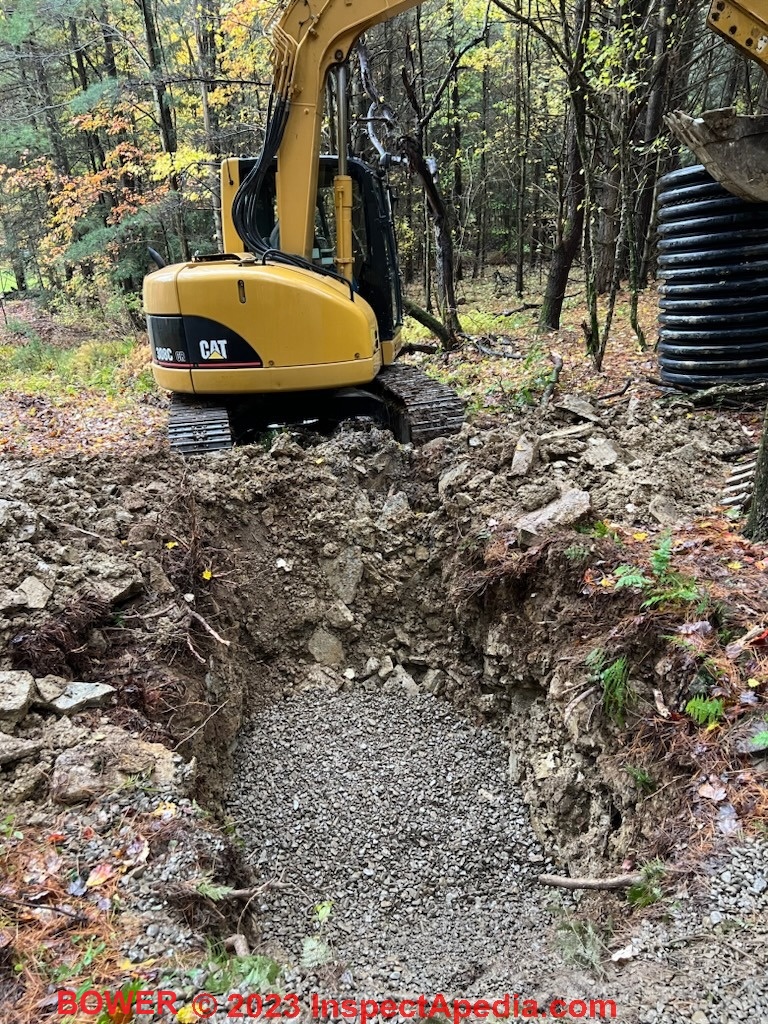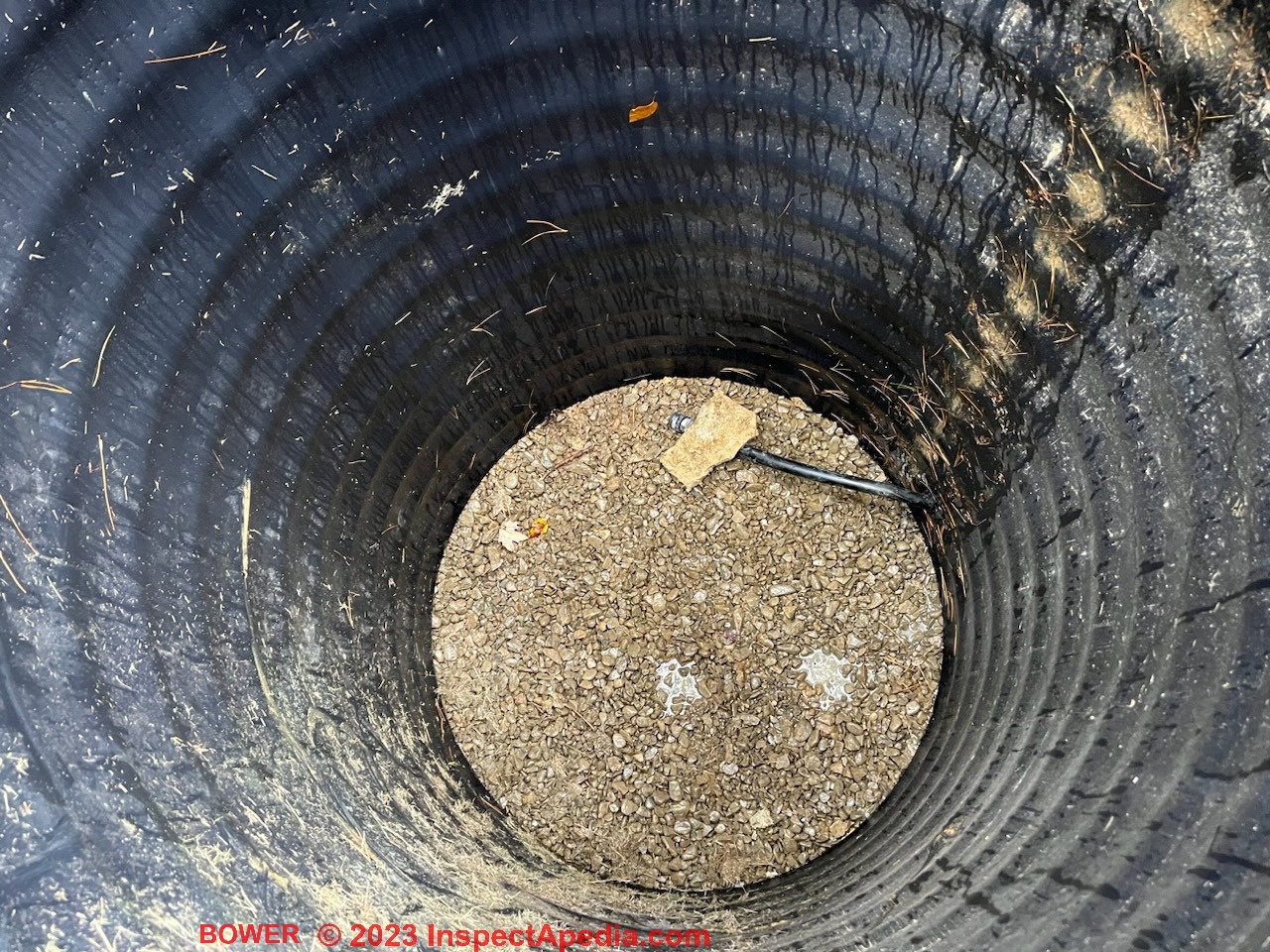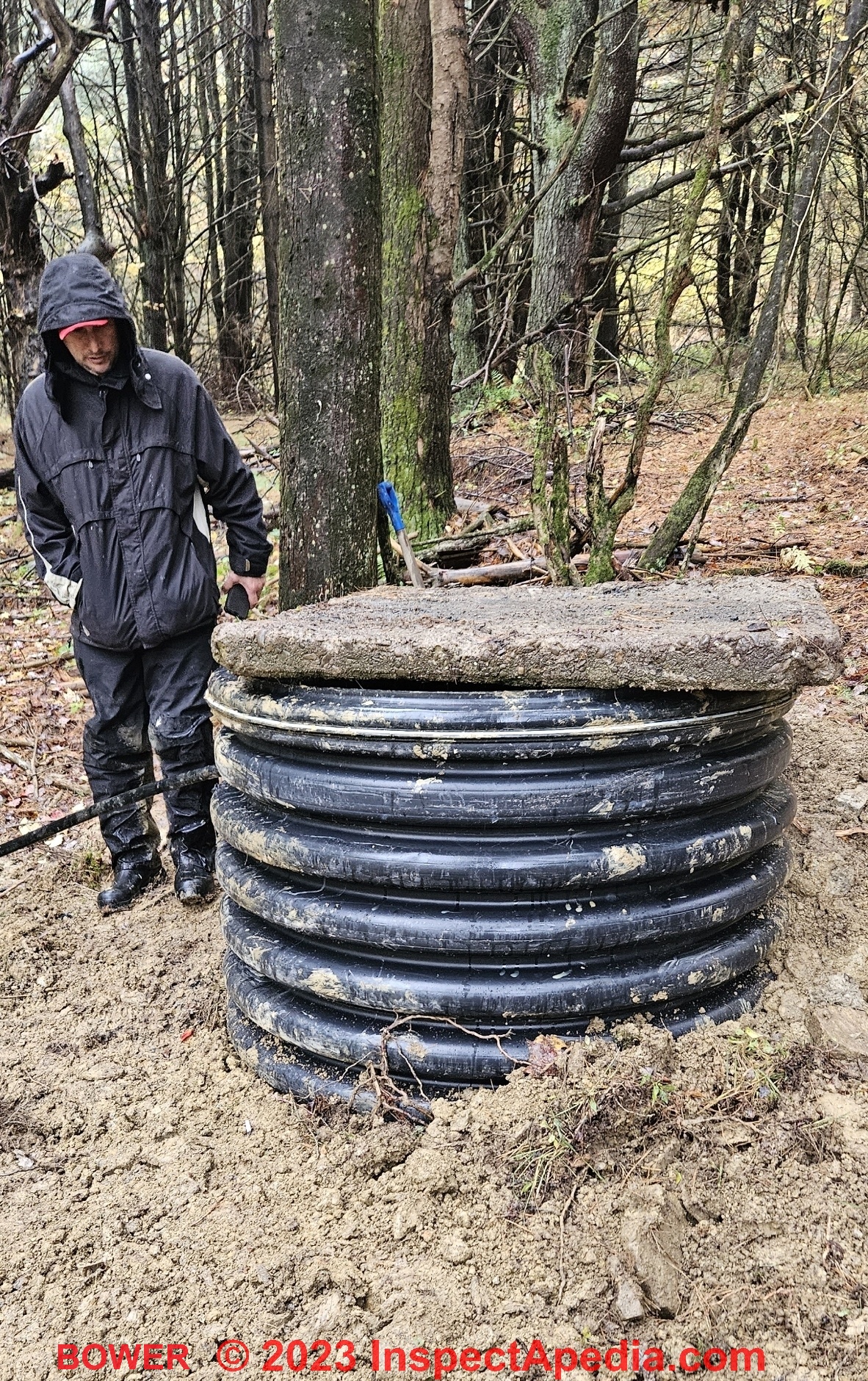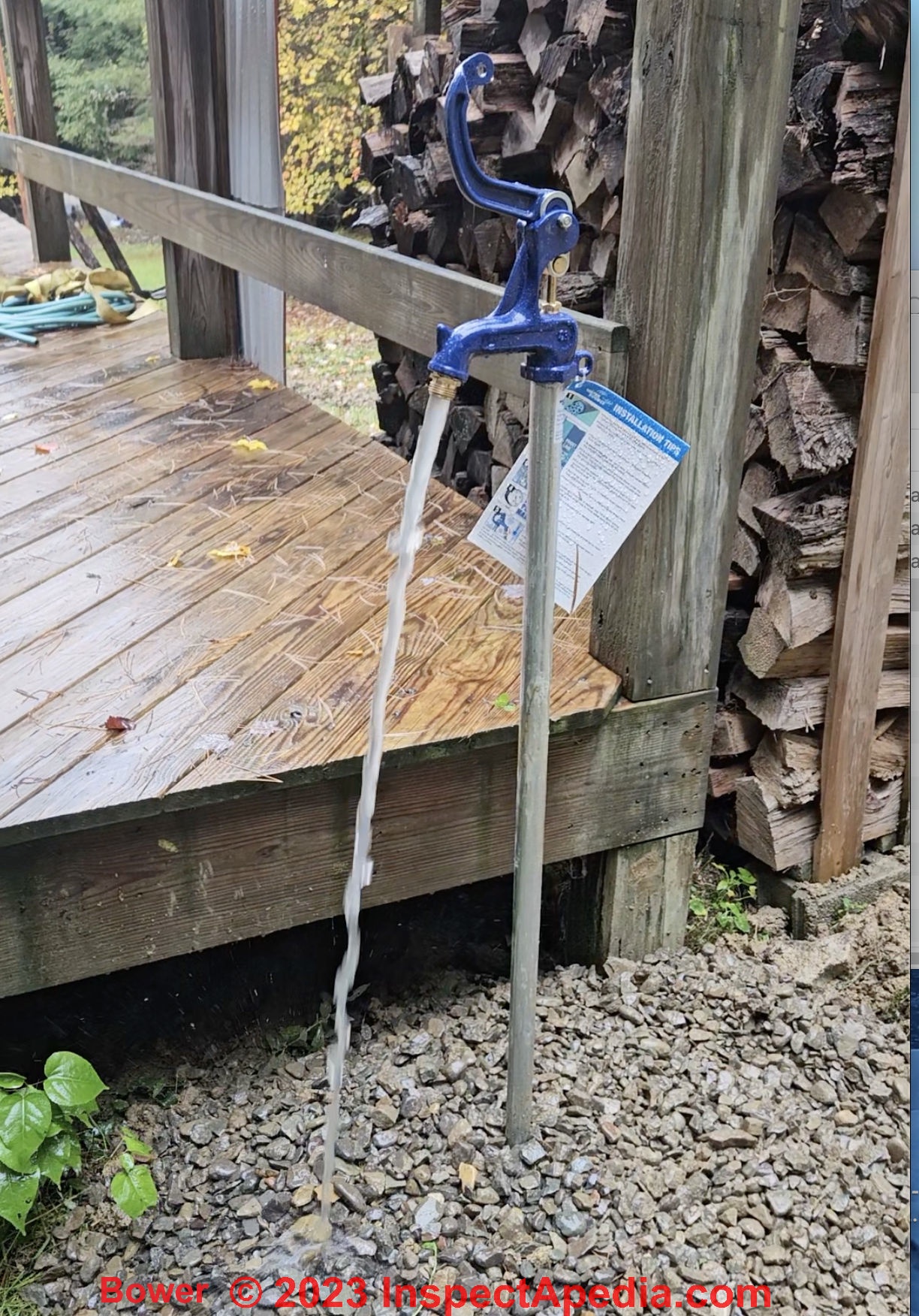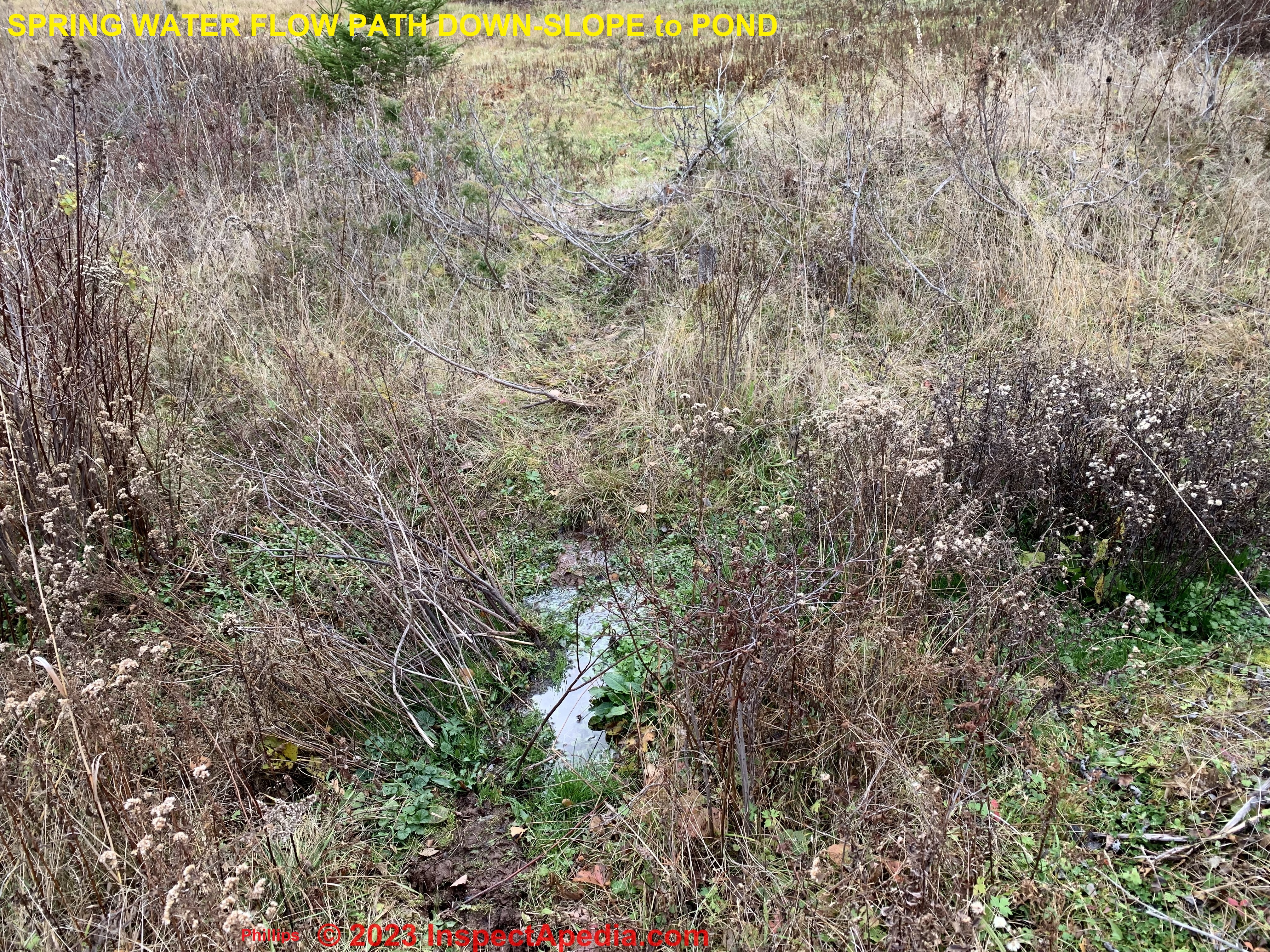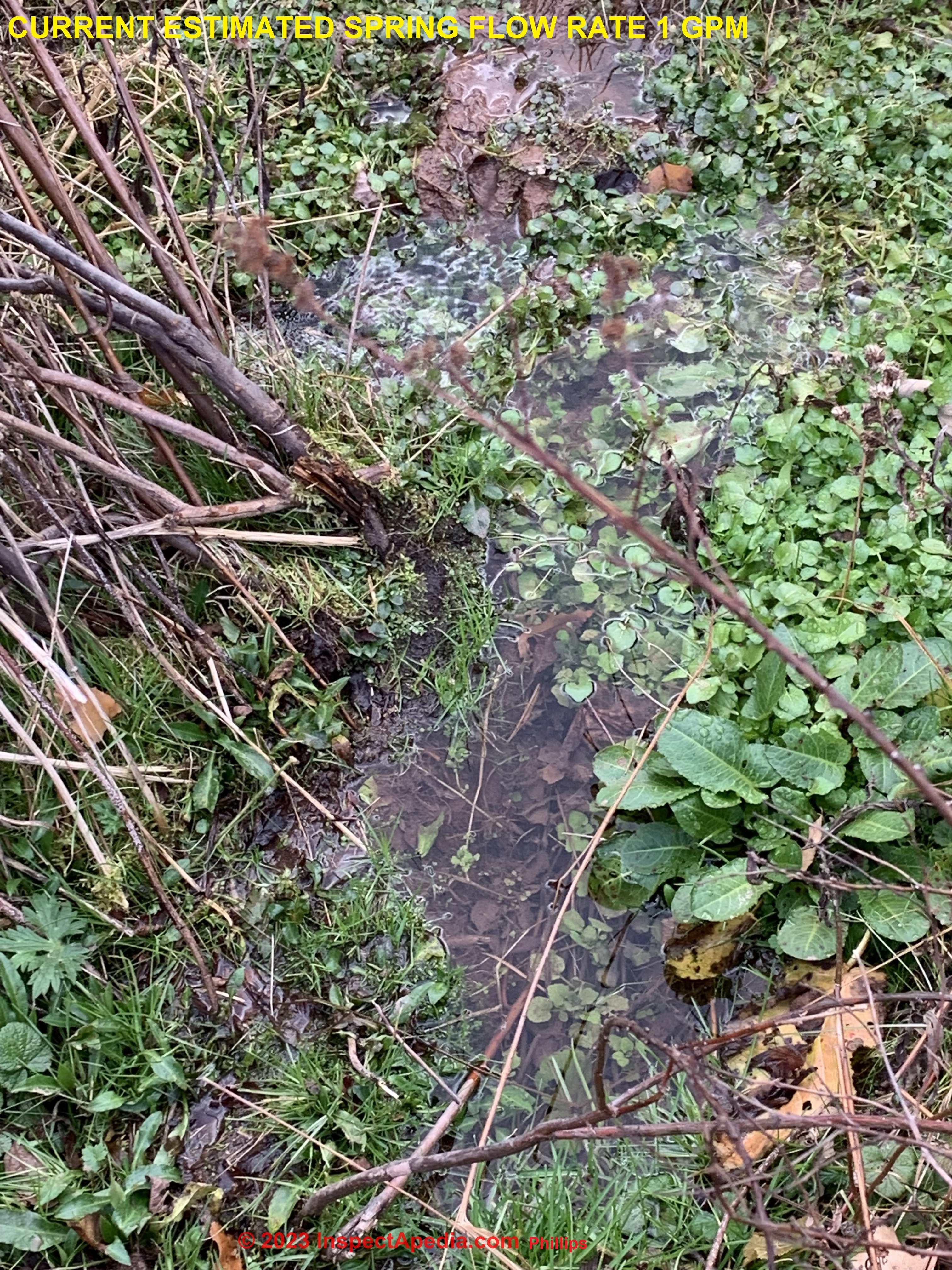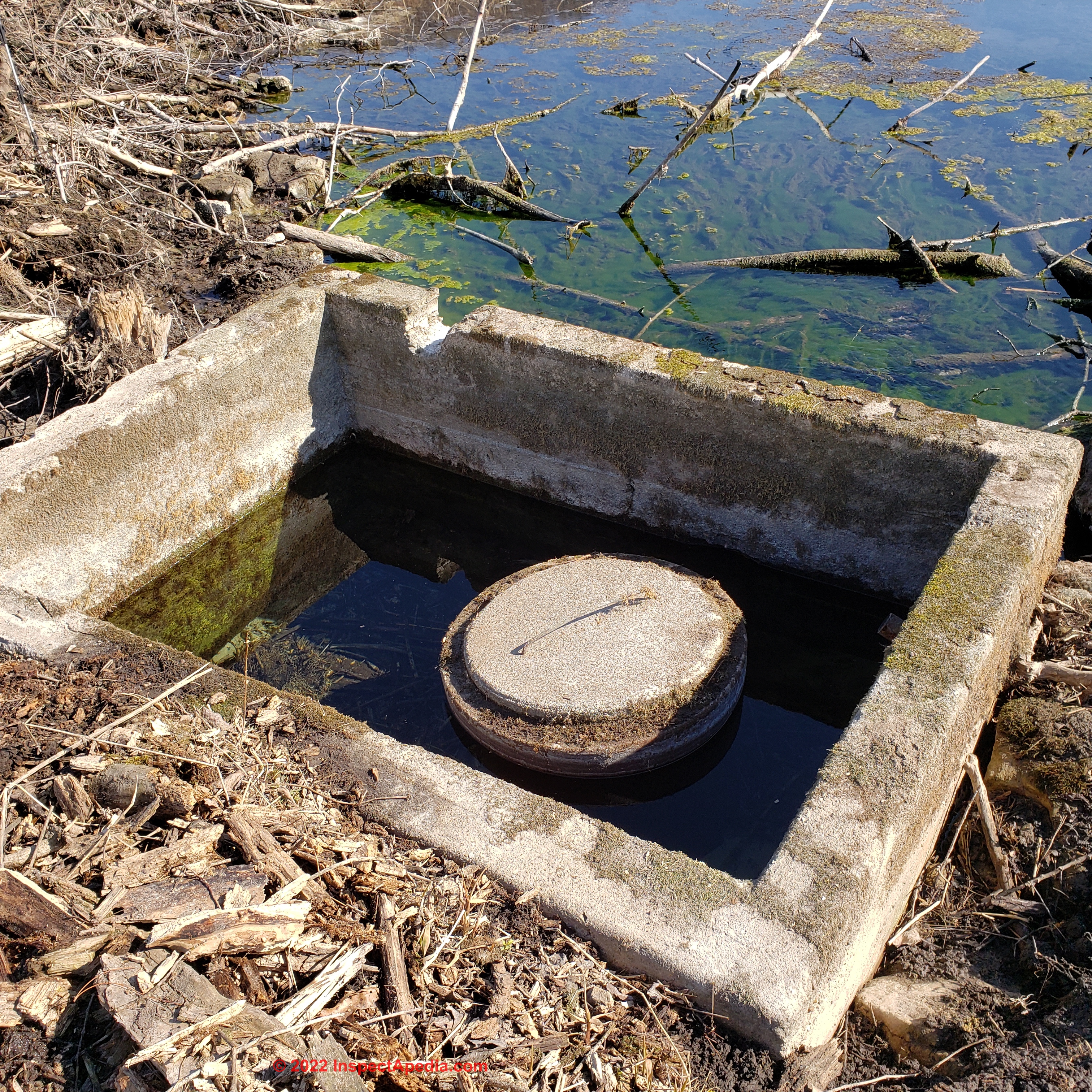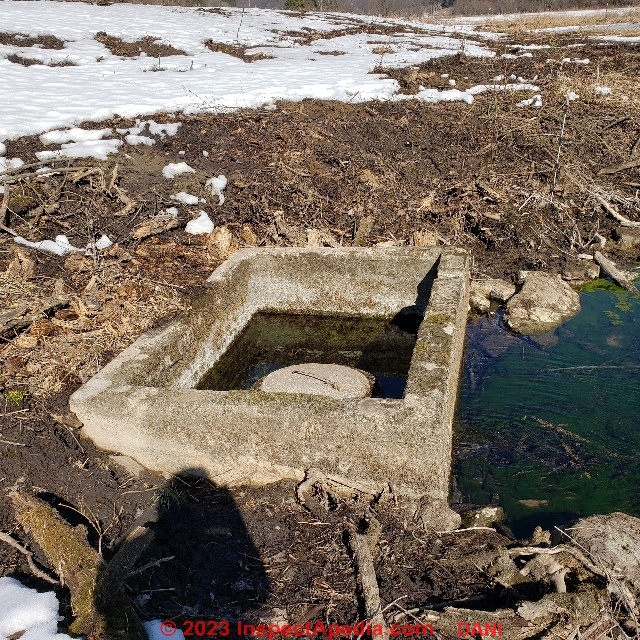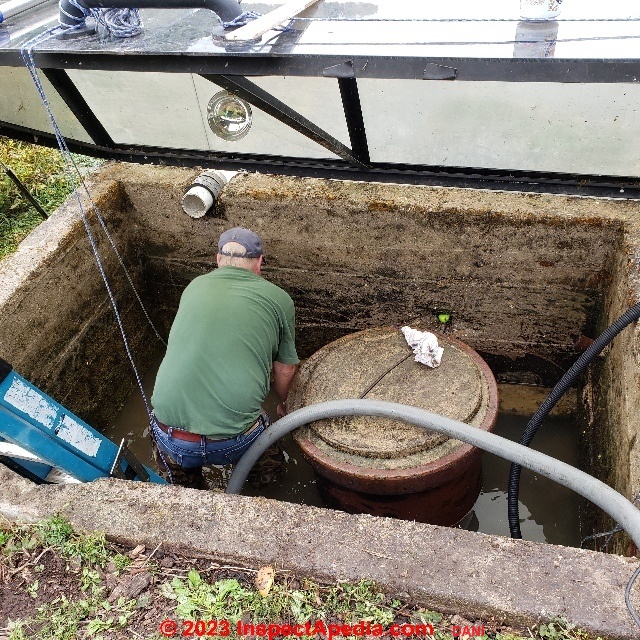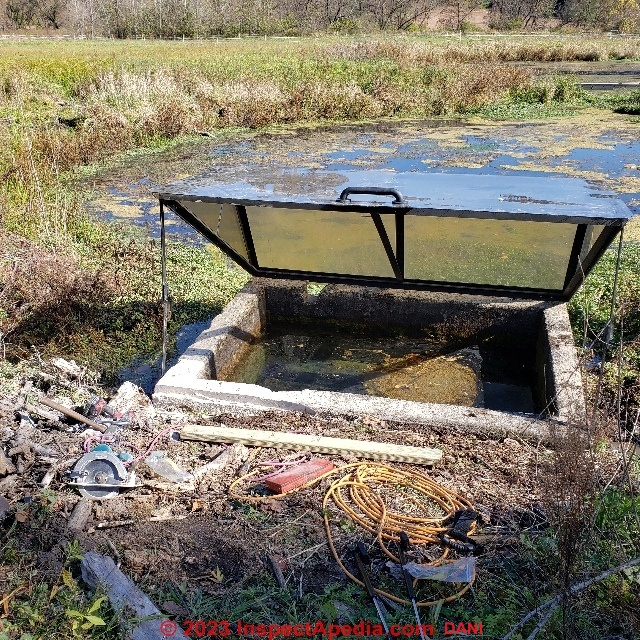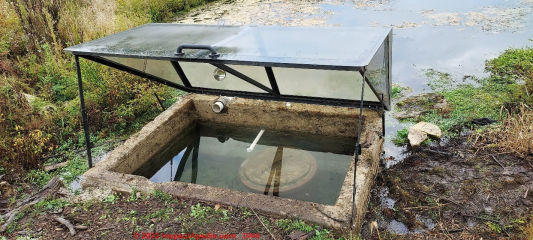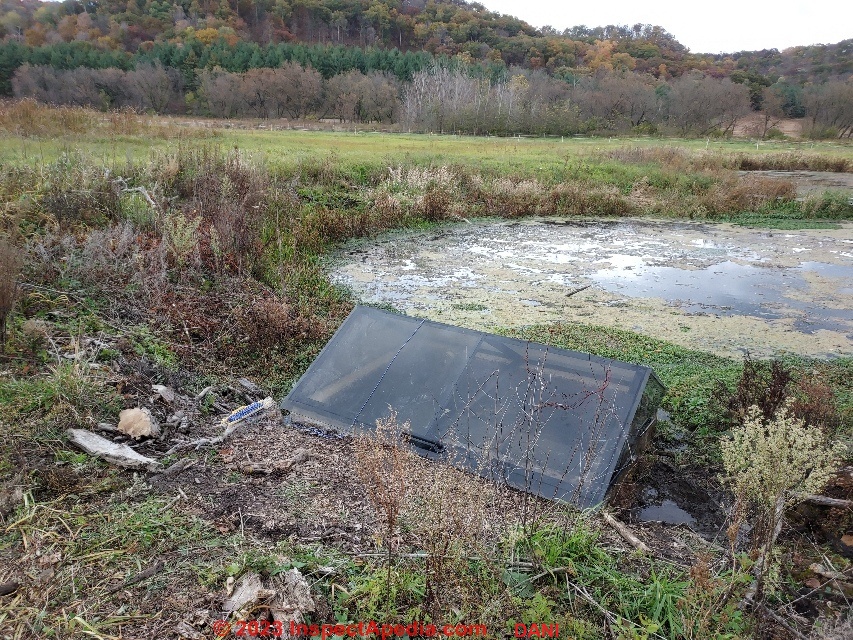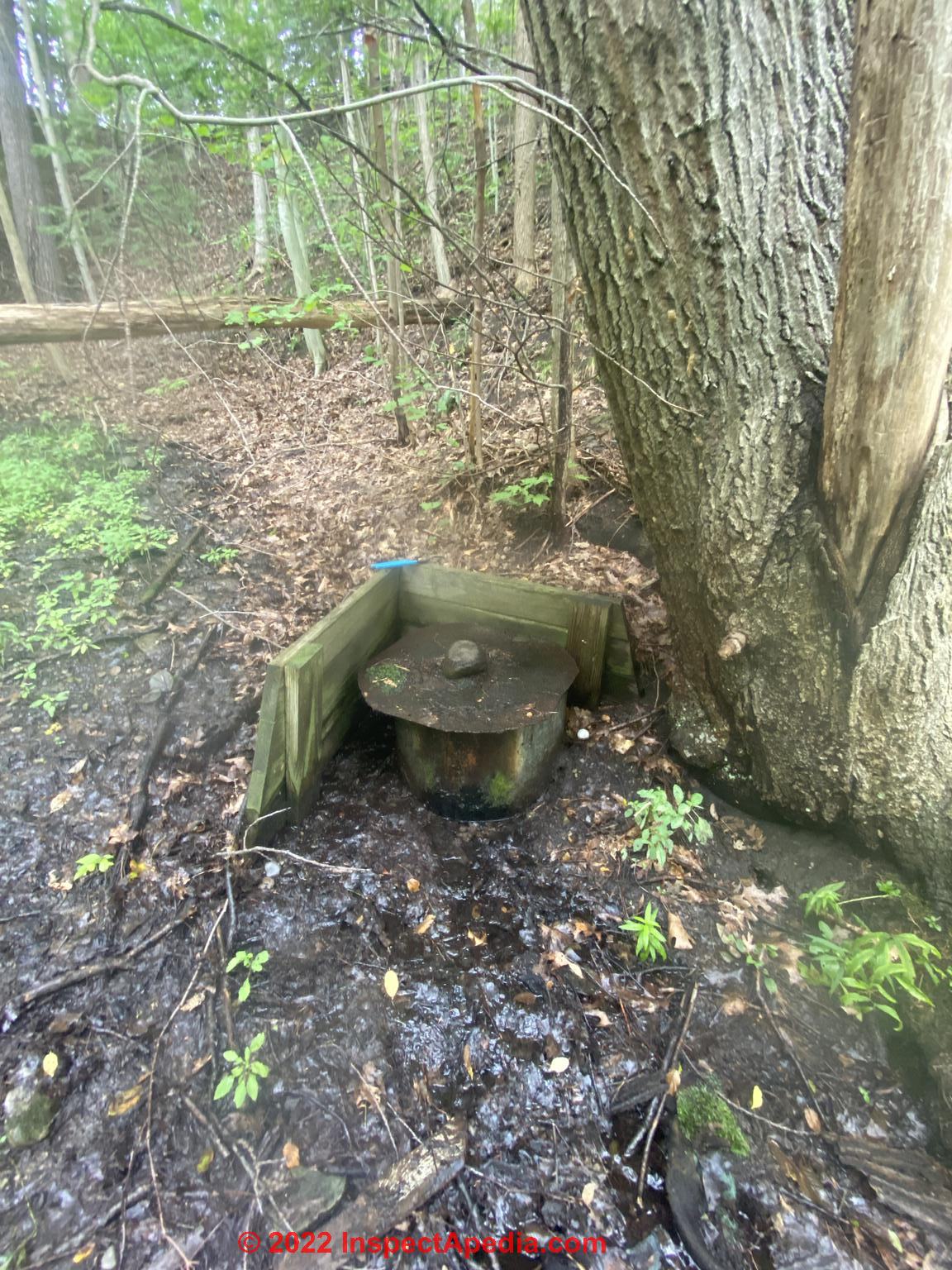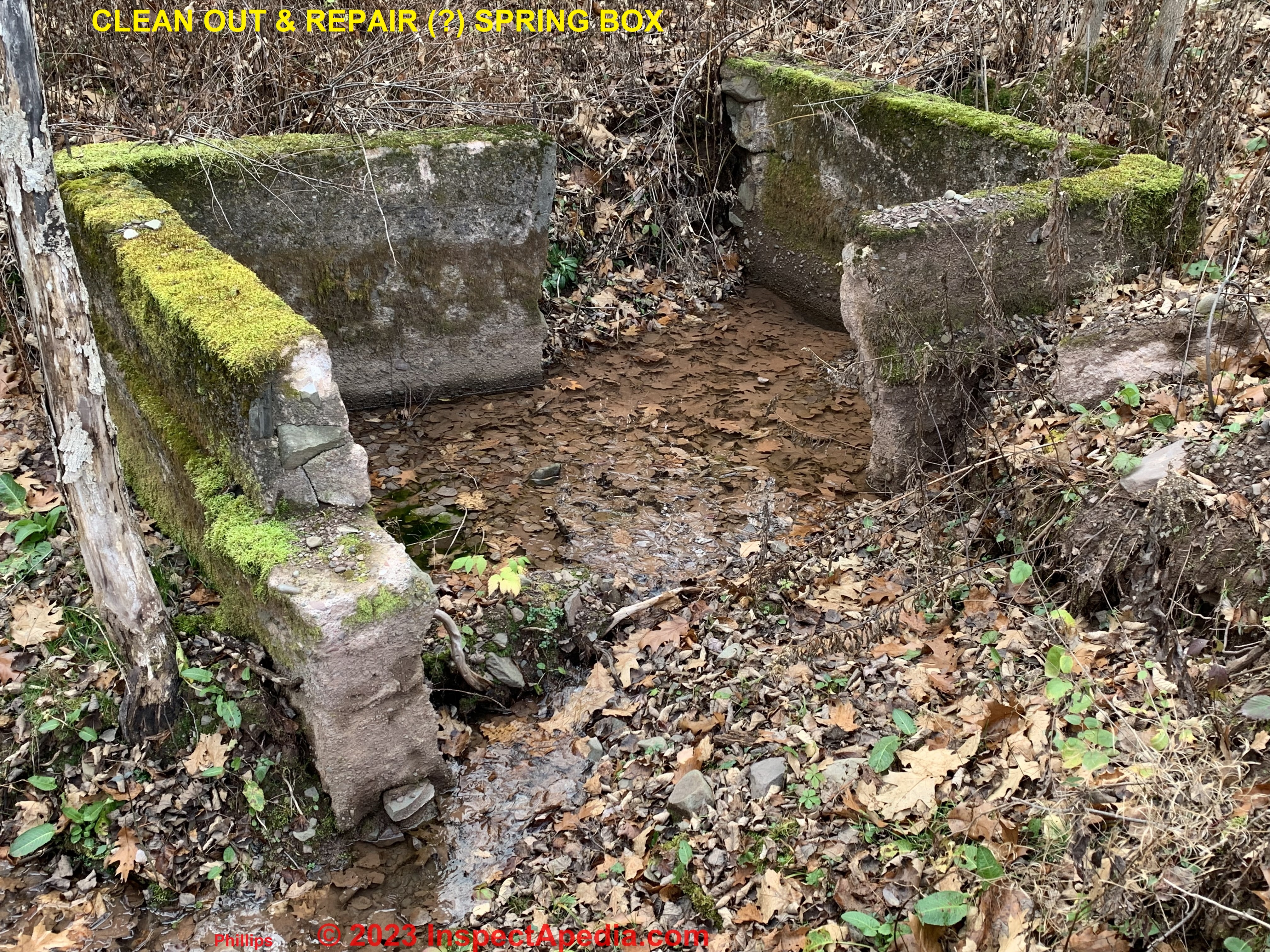 Spring Box Troubleshooting & Repair
Spring Box Troubleshooting & Repair
Troubleshoot or repair a spring box
to protect the sanitation of spring water
- POST a QUESTION or COMMENT about troubleshooting and repair of a spring water box
Spring water box repair: how to troubleshoot or repair a spring box or structure to protect spring water sources for drinking water.
This article describes troubleshooting steps and various repair methods for diagnosing and fixing a spring box.
We also describe choices of sealants to repair a leaky spring box.
Our page top photo illustrates a broken up spring box that the owner was interested in repairing.
The author's experience with spring boxes covers nearly eight decades.
This article series describes using springs for drinking water and explains issues with spring water sanitation.
InspectAPedia tolerates no conflicts of interest. We have no relationship with advertisers, products, or services discussed at this website.
- Daniel Friedman, Publisher/Editor/Author - See WHO ARE WE?
Drinking Water Spring Box: Troubleshooting & Repair
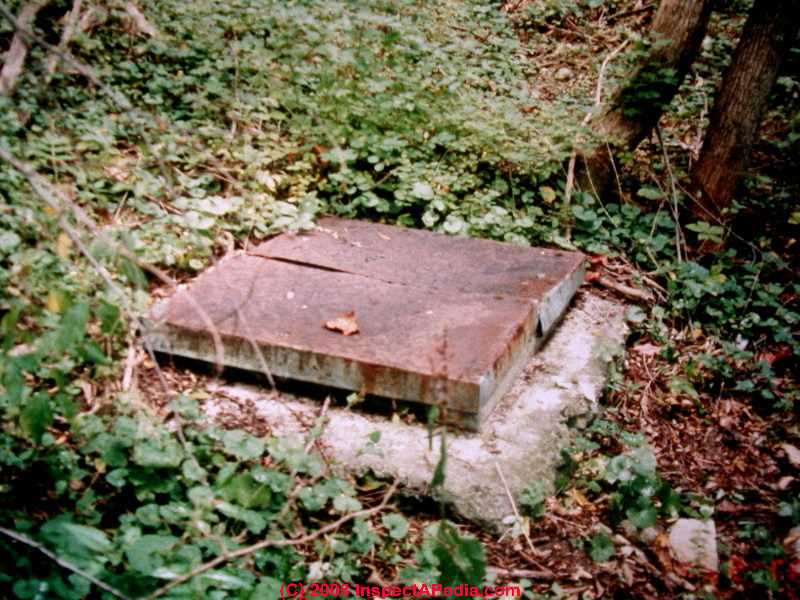 A spring house or "springhouse" is a small building constructed to collect and protect spring water.
A spring house or "springhouse" is a small building constructed to collect and protect spring water.
Here we give expet advice about what to do when things go wrong with a drinking water spring, and we discuss the differences between a spring and a seep, spring and a dug well, and a spring and other types of water sources.
The first springhouse observed by the author [DF] in 1948 was at our summer home along the Rappahannock River in Virginia in the U.S.
That spring-house, built of concrete blocks around a natural cold water spring, collected surface water to a depth of several feet.
While we have inspected spring houses of great variety in construction, location, and use, the most successful spring house designs include at least the features described in this article series:
methods to collect spring water, methods to protect spring water from contaminants, and often, methods to deliver spring water to its point of use.
Article Contents
- SPRING BOX CONSTRUCTION SPECIFICATIONS - separate article
- SPRING BOX MAINTENANCE CHECKLIST - separate article
- SPRING BOX TROUBLESHOOTING
- SPRING BOX REPAIR PROCEDURES
- SPRING BOX CONSTRUCTION RESEARCH - separate article
...
Spring Water Supply Troubleshooting
Question: we just installed a spring but we're not getting water
Photo 1: the spring site after digging out a hole and dumping in some gravel. .
I have a cabin in northwest PA. This cabin is in the Allegheny mountain area. We just put in a spring with some Amish help.
Per their suggestion we obtained a road sluce 4ft diameter x 6ft. The spring had a slow seep coming from the ground & hill side. We dug down into the spring about 3-4 ft and opened it up to hold our 48 inch sluce.
We put in about 15 in of gravel then put sluce in. The spring has been in place about 4 days.
Photo 2 above: water seeping into gravel in the bottom of the newly-constructed spring.
I expected the sluce to be filled and running out the overflow, which is not the case we have about 17 inches of water in the sluce about 40 gallons of my calculation is correct. Why wouldn't the sluce be filled and running out the over flow.
It seems to be staying at this 17 inches of water level.
Photo 3: the "finished" spring with a cover in place.
Spring is 40 ft above cabin and gravity flow. What kind of setup would you recommend by the cabin. Storage tank, pump, etc, to introduce water to the cabin.
Photo 4 above is a still clipped from this
VIDEO of WATER PROVIDED FROM SPRING [mp4] - Anonymous by private email 2023/10/26
Moderator reply: delay in water fill at new dug out spring box
Perhaps your plastic culvert material used to surround your spring is actually blocking springwater from entering its interior - which can happen if the water flow source is above the bottom of the hole into which you set the liner.
Or it may be simply that you need some time for the springwater source to find its way to your spring box.
The longer water runs through the surrounding soil and into your spring box or reservoir the more the water passage will open up. At least initially this should increase the spring's flow rate into your reservoir.
We'll need to see how this new spring performs over various seasons and in time ahead if your supplying aquifer is affected by climate changes.
Reader follow-up: spring seems enough for our needs
Once we ran a test it seems Spring will be enough for our needs.
We will have to put a Storage tank below by the cabin which should give us plenty of water.
Actually we ran a test and finding were:
Test results started at 1:44 pm spring was at 1 foot 6 inches, filled white tank to 138 gallons at 2:57 pm stop filling.
At 3:27 7 inches at 3:48 7.5 inches at 4:09 8 inches
So with that said looks like sluce quits filling at 18 inches.
Moderator reply: add large water storage tank if needed for slow-flowing spring
Thanks for the update; it sounds as if this is a typical case for using a larger water storage tank that can be filled slowly and that can provide water for surges in use rate. In our cabin (where I'm living at present) we have a small pump that delivers water at pressure from a plastic water storage tank that we re-fill on occasion.
Reader follow-up: spring worked out perfect
Spring has worked out perfect. Supplies our cabin with all the water we can use. Currently we just have an outside spicket and an outdoor shower and hot water heater connected to it.
This Spring will actually bring the water supply into the house.
We have plenty of pressure with the down hill run. We will now have to design some type of configuration for getting water into the cabin.
This may be a holding tank, filter and demand pump. The water coming from the spring is crystal clear. - Anon, 2023/12/05
Moderator reply: test spring water for potability & consider a pressure booster pump
Glad to hear you've got a good water supply.
I don't know what sort of electrical power you have at the cabin: line voltage, solar, battery, or generator. For a small installation such as a completely self-contained water system we installed in a home, we used a small pressure-sensitive transfer pump designed for water delivery. These are available in various voltages and pumping capacities.
That pump doesn't require a water pressure tank or other types contain their own small pressure regulating reservoir.
We describe some water pressure pump options including some small solar powered water pumps at
For larger buildings and where 120V is available this tankless water pump other readers may want to see this
that can provide water for an entire building and has good lift capacity.
Watch out: also be sure that the cover you put over that spring "box" (culvert material) is secure, keeps out animals and debris, and that it is child safe.
Watch out: while your spring water may look crystal clear, for safety we recommend that you have it tested for potability - at least for bacteria or coliform.
Watch out: If that were my water supply, I'd want to be sure that the plastic culvert material you used (probably PVC) is not a material that can leach harmful chemicals into the water supply. Remember that drainage culvert plastics are intended to conduct surface drainage or runoff and the culvert is not necessarily formulated to assure safe drinking water.
Identify the specific culvert product you used, find its product specifications, identify at least the kind of plastic of which it's made, and then we can research the health effects or contaminants question.
Effect of PVC Culverts on Water Potability or Chemistry or Safety
- Ackerman, Frank, and Rachel Massey. THE ECONOMICS of PHASING OUT PVC [PDF] (2003) Global Development and Environment Institute (GDAE), Tufts University (2003). - retrieved 2023/12/07, origianal source: frankackerman.com/publications/costbenefit/Economics_Phasing_Out_PVC.pdf
Excerpt from Executive Summary:
PVC poses hazards to human health over the course of its life cycle. PVC production exposes workers and communities to vinyl chloride and other toxic substances. PVC products such as medical equipment and childrenUs toys can leach toxic additives during their useful life. - Al-Malack, Muhammad H. "Migration of lead from unplasticized polyvinyl chloride pipes." Journal of hazardous materials 82, no. 3 (2001): 263-274.
- Heim, Timothy H., and Andrea M. Dietrich. SENSORY ASPECTS AND WATER QUALITY IMPACTS OF CHLORINATED AND CHLORAMINATED DRINKING WATER IN CONTACT WITH HDPE AND CPVC PIPE [PDF] (2007) Water research 41, no. 4 (2007): 757-764. - retrieved 2023/12/07, original source: sciencedirect.com/science/article/abs/pii/S0043135406006713
Abstract:
Pipes constructed with high-density polyethylene (HDPE) or chlorinated polyvinyl chloride (cPVC) are commonly used in drinking water distribution systems and premise plumbing. In this comprehensive investigation, the effects on odor, organic chemical release, trihalomethane (THM) formation, free chlorine demand and monochloramine demand were determined for water exposed to HDPE and cPVC pipes.
The study was conducted in accordance with the Utility Quick Test (UQT), a migration/leaching protocol for analysis of materials in contact with drinking water. The sensory panel consistently attributed a weak to moderate intensity of a “waxy/plastic/citrus” odor to the water from the HDPE pipes but not the cPVC-contacted water samples.
The odor intensity generated by the HDPE pipe remained relatively constant for multiple water flushes, and the odor descriptors were affected by disinfectant type.
Water samples stored in both types of pipe showed a significant increase in the leaching of organic compounds when compared to glass controls, with HDPE producing 0.14 μg TOC/cm2 pipe surface, which was significantly greater than the TOC release from cPVC.
Water stored in both types of pipe showed disinfectant demands of 0.1–0.9 μg disinfectant/cm2 pipe surface, with HDPE exerting more demand than cPVC. No THMs were detected in chlorinated water exposed to the pipes.
The results demonstrate the impact that synthetic plumbing materials can have on sensory and chemical water quality, as well as the significant variations in drinking water quality generated from different materials. - Nikiema, Josiane, Javier Mateo-Sagasta, Zipporah Asiedu, Dalia Saad, and Birguy Lamizana. "Water pollution by plastics and microplastics: a review of technical solutions from source to sea." (2020).
Excerpt:
The lowest microplastic concentrations were measured in ponds that collected stormwater from highways and residential areas, while the highest were associated with industrial and commercial areas. Key plastic polymers included PVC (in the case of larger microplastics), PP, PE, PET and PS. - Whelton, Andrew J., Kyungyeon Ra, Seyedeh Mahboobeh Teimouri Sendesi, Md Nuruddin, Xianzhen Li, John A. Howarter, Jeffrey P. Youngblood, Chad T. Jafvert, and Nadezhda N. Zyaykina. "Contaminant Release from Storm Water Culvert Rehabilitation Technologies: Understanding Implications to the Environment and Long-Term Material Integrity." (2019).
More water test advice is at
...
Spring Box Repair Recommendations
 Case 1: Proper Water Spring Box Design: how do I fix up a leaky spring box - walls are cracked & leaking
Case 1: Proper Water Spring Box Design: how do I fix up a leaky spring box - walls are cracked & leaking
I would like to see if you have any ideas for my spring. I purchased this property last year. While I was deployed to Afghanistan my wife dug out a portion of the spring; approximately 4 feet deep.
She then filled it up with rock. Then she put a 2 inch pipe with numerous holes drilled into it.
Ran a pvc pipe to the house with a shut off valve. The spring box is constructed of 4 inch concrete walls. I'm not sure the depth of the walls.
The [surrounding spring] walls are in disrepair.
One wall had already cracked which may be caused by the pressure from the ground. Another wall has a leak which has filled an area in front of the spring box full of water creating a little pond.
Two weeks ago I dug down about 18 inches to find the leak. I thought I found it and used some hydraulic cement to patch it up. It is still leaking in the same area.
My initial thoughts were to put another concrete wall up just inside the other one. Go down about 4 feet and tie into the other wall with some rebar.
Do you have any suggestions that may be more effective?
I have a few short videos if that would help. - A.S. 6/15/2013
Reply: A Properly Built Spring Box is Important for Protecting the Potability of Spring water.
A.S., please first review SPRING BOX CONSTRUCTION SPECIFICATIONS - since the details of good initial construction of a spring water protection cover will help you decide how far to go in fixing the leaks in your spring surround.
Then continue reading below where we discuss approaches to patching a leaky spring box.
With regard to digging out the spring and using rock:
Digging out a spring can improve the water quality by giving space for debris settlement; it can, depending on design, also give a larger water drawdown reservoir if the spring water is to be delivered by pump; but in general it won't increase the absolute water yield quantity from the spring itself.
Digging out a spring, to the extent that it removes leaves and debris, is also important for water quality.
Watch out: unless sanitary spring water is reaching the ground surface and unless the spring water is protected from other contaminants, it will not be possible to assure that spring water is always sanitary and thus safe to drink. In such situations you'll want either a water sanitizing treatment system or at the very least, regular water testing for potability. Read more at
SPRING BOX CONSTRUCTION SPECIFICATIONS
OPINION: I'd have preferred a larger water reservoir that could be cleaned; the rocks mean debris settles through the rock and can't be cleaned without taking out the rock.
IF the rock was put into a spring to try to keep it "open" a better approach would be a surrounding concrete wall.
With regard to the pipe connection to the house and leak repair:
OPINION: makes perfect sense, though still we'd want a water reservoir to improve drawdown rate in times of demand, and see my caveat above about spring water potability.
Watch out: a spring box that leaks water "out" may catch your attention because of the reduction in water supply, but a still greater risk is that surface contaminants can leak into the spring water. For both reasons, I agree that you need a spring box whose walls and top cover do not leak into the spring.
Surrounding a spring with watertight walls is a good way to reduce surface runoff into the spring.
There are both cement and epoxy repairs that can work to fix a leaky concrete spring surrounding wall, though you'll want to choose a sealant that does not itself contaminate your drinking water - one rated for potable water containers.
With regard to cracks from frost heaves:
If the spring walls are cracking from frost heaves then they'd need to be removed and rebuilt with footings below the frost line.
Some springs in freezing climates deliver water year -round at a temperature and rate sufficient to prevent freeze-ups, others not.
Photo above: unprotected drinking water source from a spring, Jalpan, Queretaro, Mexico - Daniel Friedman
Cracks from frost heaving are typically vertical or diagonal or (if the surrounding wall is masonry block) stair-stepped;
Cracks from horizontal frost push against the spring box walls tend to be horizontal.
If your wall damage was from horizontal push you might reduce that problem by burying solid foam insulation against the outside of the spring walls + improving surface drainage around the spring box.
With regard to the leaking patch:
Sounds as if your patch is leaking, or there is another leak, or the water supply itself has dropped. Just putting up another wall outside the existing one sounds a bit "Rube Goldberg" or "makeshift" to me. I'd want first to get an accurate diagnosis of the problem.
OPINION: while lots of us grew up drinking spring water. (I did, in Dunnsville VA), because spring water. is no longer reliably sanitary in many areas, and more, if your water quantity and flow rate may be inadequate, I'd keep the investment in the spring to a minimum of time and money.
Ultimately you may need a more costly sanitary well drilled to provide a reliable potable water supply.
Case 2: what to use to patch a leaky spring water. container, liner, or leaky masonry
I have a hand dug and stone and cement spring at my camp which isn't holding water very well.
I want to patch the inside with something that can stay wet and won't be toxic, any ideas? - D.H. 4/3/2013
Leo said: My well is 15' deep, with a cement-wall surround of about 3' x 10'. There is a large crack in one corner which is settling. Can you recommend a non-toxic cement to repair the crack please. - 2018/05/27, posted originally
Reply: approaches to sealing a spring box, hand dug well liner, or other container intended to contain potable water
D.H. and Leo:
- Hydraulic cement,
high in portland content, is compatible and as it's essentially the same as what you've already got - concrete - about the same in toxicity.
But if the cracks and leaks are because the concrete structure you built to contain spring water. is tipping, bending, breaking, leaks will probably recur until you fix the underlying support.- Silicone sealants & aquarium sealers:
an alternative that is surely not toxic would be to try a silicone or similar sealant sold for use in constructing an aquarium.
If we have a product that doesn't kill the fish that's a good sign.
As you will see from our clip of advertisements for aquarium sealers in our photo above, these are generally silicone sealant products sold by Ag, DAP, DOW, Marineland, Perfecto, and other manufacturers. [Click any InspectApedia.com image to see an enlarged detailed version.]
To use an aquarium sealer or other non-toxic silicone sealant the surface will need to be clean and dry and you'll need to be able to keep it dry until the silicone sealant cures. Typically that's at least 24 hours.- Swimming pool patch compounds:
an alternative
Watch out: for which you'd need to read the MSDS but that might work well would be swimming pool patching compounds. Some of these products have the advantage of working when applied under water.- Other caulks & sealants:
Really? I am hesitant to recommend some of the excellent caulks and sealants without checking the caulk's chemistry.
But in general, the most toxic chemical in some caulks would be mineral spirits (possibly a source of benzene, a carcinogen, for example).Acrylic / latex caulks, do not contain mineral spirits but our research indicates that it would usually be more accurate to call these products "low toxicity caulks and sealants" rather than "non-toxic". Nothing, not even water, is completely "non-toxic".
For example, DAP's Acrylic Latex Caulk is such a product, and is available in versions that include or exclude silicone. Silicone, itself rather inert when cured, is key in making a caulk waterproof.
- See CAULKS, NONTOXIC for details about choosing a non-toxic or at least low toxicity caulk or sealant.
- See CAULKS & SEALANTS, EXTERIOR for details about selecting and using these products
Watch out: surface preparation is also key to a successful caulk or seal job. Be sure that the areas around the cracks or sealants you are using are clean and if the sealant requires, also dry and at a suitable temperature.
Watch out: leaks in a spring box or dug well masonry liner such as walls made of concrete or cement and stone may be due to movement caused by earth pressure, frost, or settlement. If the causes of the movement are not identified and fixed, just patching a crack or leak is not likely to be a long-lasting repair.
Case 3: Repair options for a broken up spring box
How can we make this spring box usable?
I’ve been reading information on your web page about springs and wondered if you might have some insight into this spring situation. It’s a spring in upstate New York on property I just purchased. It’s basically going to be a place to camp, but it would be wonderful to be able to access this water.
The water bubbles up from a seep , and runs down to feed pond below. I can see where it bubbles up from and I’ve built a temporary dam around it to determine how much water it gets.
It’s not as full now as this image is taken in early spring. I do not know how much water it produces during drought times.
But currently (July 2023) it’s about a gallon a minute. The run off to the pond is completely choked up now and very little of the spring water actually makes it to the pond.
Should the springs path that runs to the pond be cleared ?
Or should it just be allowed to grow over with plants naturally?
Can I create a small dam within the s structure that is already in place ( falling/ apart) with concrete blocks, without taking out the old box?
Would building a catchment wall with clay and rocks be a more natural alternative. Simple solutions? Ideas.? - Anonymous by private email 2023/07/03
Moderator reply: simple option for restoring a spring and routing its water to a pond
Just how much work you do to clean out, restore, and protect that broken-up spring box depends on what use you want or need to make of the spring water. I infer from your question that you'd like to simply get the spring water down to a pond on the same property.
Some of the spring restoration articles we cite at this page point out that a less costly spring restoration alternative to a new or repaired spring box is to simply clean out the spring source and build a protected channel that allows spring water to flow downhill to a destination such as the pond that you mention. (Hart 2003).
You would
- Dig out the spring eye
(probably centered in the remains of the concrete structure in your photo) sufficiently to remove accumulated debris and to improve its flow rate.- Protect the spring eye
from washing-in leaves and debris, perhaps adding a stone wall surround and headwall.
Excerpting from Skinner & Shaw cited below,
The spring eye at the head of the trench should be surrounded with clean stones through which water can flow into the trench. Stones of between 10 and 40mm diameter are usually suitable for this, but larger ones can be used.
A layer of stones about 100mm deep will usually suffice, and this should then be covered with a layer of rocks and a layer of 'puddled clay' about 100mm deep.
This clay is prepared by wetting and kneading it underfoot until it is uniformly plastic. Its purpose is to prevent surface water and grains of backfill material from entering the stone-filled channel.Illustrated above: using a pipe to conduct spring water to a small pond - excerpted from Skinner and Shaw cited in detail below.
- Clear and line a small stream path down-hill
from the spring to its destination to route a drainage ditch or to bury a PVC pipe.
Here are excerpts from Hart's 2003 treatise that we cite and offer as a free PDF download on this page:
Spring boxes aren't the only method of protecting spring water sources. There are alternative structures that may suit the needs of the community better than a spring box.
For example, if the distance from the spring eye to the primary distribution point isn't great, a stone-filled trench and headwall may be a preferable method of spring water protection.
...
The basic design of a stone-filled trench and headwall is to dig a trench from the distribution point to the spring eye. The trench should have a fairly impervious bottom to minimize water loss to infiltration. Two options exist for transporting water from the eye to the distribution point,
the first is to simply fill the trench with clean stones and a layer of puddled clay approximately 100 mm thick over the stones in order to prevent surface water from infiltrating and contaminating the source.
The second option is to pile clean stones over the eye, protect the source with a layer of puddled clay, and use a plastic pipe to convey water from the source to the distribution point. This method has several advantages over the stone-filled trench.
First, if the topography allows, the pipe can be situated so that the outlet is above ground, eliminating the need to construct a large headwall. If this method is used, it is necessary to protect the above ground portion of the plastic pipe with a short length of steel pipe.
With either method, a concrete headwall will need to be constructed at the outlet with a concrete apron below the outlet pipe to provide easy access and to prevent erosion.
Hart describes a second option, developing a horizontal well that is more useful at a steeply-sloped cite that from your photos we think is not your case.For the situation you describe, the simplest and most-effective way to restore that spring to feed a pond down-slope on the property would be to add large stones to form a wall to protect the remains of the existing spring box from sticks and debris that otherwise wash down into the opening at the up-slope and broken spring box wall, then clean out the spring and build just enough of a headwall to feed a 4" or 6" pvc pipe that brings groundwater down to the pond below.
In my view, though some minor digging is needed so that we don't have an ugly plastic pipe on the surface of the slope down to the pond, that's less cost and less work than building a stone-lined ditch down to the pond. But you may prefer the ditch, perhaps lined with a waterproof membrane and then sufficiently-large stones as to stay in place.
The ditch or trench option will require periodic maintenance to clean out sticks and leaves.
Case 4: Spring Box with Center Concrete "Cistern" by a Pond
2021/07/11, Anonymous: standing spring box with round concrete-covered center "cistern"
I found you email on a blog about springhouses and you seem to be very versed on the subject so I thought I'd shoot you an email to pick your brain
Recently we purchased a property with a standing spring box on it. We were told by the prior owner that at one point the water was sold for bottling (we have not tested it as of yet).
Anyways we'd like to cover it up by building a spring house over it but are kind of at a standstill for ideas. We also have no idea what the circular thing is with the lid on it in the middle of it. A cistern? a filter?
It is a rather large spring box approximately 6ft wide x 8ft long and about 4ft deep.
We would like to add more sand to the bottom and make it look cleaner.
We have been cleaning out the sticks and debris and using it for icy dip bathes after workouts. Any ideas, help or otherwise old world-y knowledge would be much appreciated. - Anonymous by private email - 2021-07-10
Moderator reply: Identify the round concrete-cover and construction in the middle of this concrete spring-box
Far more thorough and detailed advice on using spring water, building a spring-box, protecting the water, testing it, etc. than I can type anew, off-the-cuff, here, are organized beginning at
SPRING BOX CONSTRUCTION
Please take a look at that material, and don't hesitate to ask any specific follow-up questions as you may need.
Watch out: about water quality and safety from springs, you'll also want to read the other Recommended Articles at the end of that page, such as the caveats for
SPRINGS as WATER SUPPLY
About that round center manhole type cover in the center of your springbox, it's not a construction with which I'm familiar. I would open the cover and look inside - it may be a construction designed to allow water into the springbox from deeper soils, or ... something else.
Does the pond feed your spring box or is a spring feeding the pond?
Your photos show surface runoff running into the spring box but also that it is right next to a pond.
The fact that your "spring box" is immediately next to a pond suggests that the water inside the "spring box" is either receiving water from the pond - in which case it is certainly not sanitary as the pond is getting surface runoff from the surrounding area - the pond feeds the spring.
or
the spring-box could in fact be built over and around an actual spring-fed water source that sends water into the spring water out from the source and into the pond - the spring feeds the pond.
If it's there to permit groundwater from the spring to enter the spring box, it will be deeper than the box shown in your photo and will have perforations that allow water to rise up through it into the spring box.
Someone might build that (this is speculation) to permit deeper (supposedly better) water to enter the spring box while at the same time preventing unsanitary surface runoff from entering the enclosure.
When you open the lid, take more photos to show us what you see and we can comment further.
Watch out: for safety, never work alone around pits or holes into which you could fall.2023-09/18 Reader Update: Repaired Spring Box by a Pond
In July of 2021 I contacted you about a larger spring box and a round structure inside. You posted the pic on the blog. Well, its been 2 years and we have manged to cover the box and just a few days ago made it into a functioning structure again.
Here is a picture (above with worker inside) of how deep the springbox is once it was pumped down and one of how it looks when its closed.
Attached is the cover made with an all aluminum frame and recycled Lexon glass salvaged from a school. It has hydrolic lift arms and locks to keep it open to maintain the springbox. The next pic is it installed in 2022.
Photos (above and below) show the box after it was pumped out, holes patched and new outlet pipe was drilled.
The final picture is after the walls were pressure washed and all the debris was skimmed out as best we could.
It was no small task removing the water. A lil trial and error and one last kick at the cat put us with a 3 inch trash pump that made short work against Mother nature.
As the water level dropped several holes where previous outlets had been drilled were revealed.
These outlets were patched using backwoods enginuity and not limited to; a tennis ball, shop rags and a golf ball wrapped in shrink wrap to stop the flow of water so hydrolic cement could set.
We were unable to determine exactly what the round concrete is inside the springbox. The cover is so heavy and the angle where it is located is too steep to safely get heavy equipment in. Our best guess is a cistern that at one point fed the house with water.
As of now we have not had the water tested for safe drinking. We will have it tested out of curiosity and not necessarily that we want to drink it.
I have to say, the journey to get it back to functioning wasn't easy, it was a real head scratcher but the end result has been so worth it. - Anonymous by private email 2023/09/18
Moderator Reply: possible role of center concrete cistern in spring box, and which way is water flowing: spring to pond or pond to spring?
Thank you so much for this update - Indeed this is a really nice project and I have added it to what we had before - for you and other readers to comment.
How did you attach the salvaged Lexan clear plastic glazing to the spring box cover frame? Two sided foam tape?
The holes that you report finding in the spring box wall, presumably on the "pond" side suggest that it was intended to both collect water from a spring source and to feed water into the adjacent pond, while perhaps reducing backflow of less-clean water from the pond into the box.
That round concrete cover atop what looks like a fired clay well ring might indeed indicate a cistern but it's a bit odd to build a cistern inside of an existing enclosure.
Possibly it is actually protecting a more deeply excavated hole intended to feed water into the spring. If that is the case, cleaning out that inner chamber may increase springwater flow into the springwater collection "box".
I'd be surprised that we'd need heavy equipment like a backhoe simply to remove that cover. Usually two people can lift a round concrete cover over a spring source or manhole by sliding an iron bar under the raised handle and using a lift person on either side - but indeed I agree that it's not worth a hernia if tried alone. - Mod. 2023/9/18
Reader Comments, Questions & Answers About The Article Above
Below you will find questions and answers previously posted on this page at its page bottom reader comment box.
Reader Q&A - also see RECOMMENDED ARTICLES & FAQs
Thank you for the information on springs and wells on your pages! I want a more secure spring box lid.
Thank you for the information on springs and wells on your pages! I'm writing about a spring that serves as the primary water source for our house. The water tests clean and we have a sediment and UV filter prior to the water entering our holding tank in the house via gravity (it's about 250' away on a hillside behind the house).
The spring is basically a metal pipe about 24" in diameter, and I'd like to improve the security with a better/locking lid and also some improvements to reduce the amount of sediment/runoff around the pipe.
None of the sediment appears to be making it into the water supply, but I'd like to keep it that way. Water simply overflows the top when we're not pulling water. Any suggestions or resources you could suggest? Thanks! - On 2022-09-12 by Carlos -
Reply by InspectApedia-911 (mod) - improve the security of the lid and reduce the amount of sediment/runoff
@Carlos,
If the current top of that steel "spring box" is above the snow line then you might simply get by with a hinged cover and hasp and padlock.
A welder hand-carrying the necessary equipment for gas welding can weld on hinges for a cover and the bits for a padlock or else you're faced with a DIY project using all mechanical means: a drill and your own hardware.
The fact that your spring is in essence overflowing the container top means you need to provide an exit path for water below or at the downstream edge of your cover.
To avoid re-entraining surface runoff and also to avoid creating a muck mess around the spring I'd suggest a bit of digging to provide runoff direction to an acceptable destination.
Before starting your spring box improvements, check again that it provides sufficient water volume and pumping or flow rate in its present size.If not you'd want to enlarge the enclosure before adding a secure cover and grading to protect against runoff.
Is it safe to use an old spring house ? How do I restore it ?
I have an old spring house on my property and I am going to use it for my water supply. My uncle grew up using this water source but has been neglected for about 10 years.
It is a concrete block building but from the looks of it has a mud bottom. Is this safe to pump water out of? Or is there a way to concrete the bottom and is this necessary? - On 2022-09-13 by William Griffin -
Reply by InspectApedia-911 (mod)
@William Griffin,
You may want to clean out mud, but before cementing the bottom you need to ascertain how water enters the spring box.Followup by William Griffin
@InspectApedia-911 Thanks for the information, if I clean out the mud is it necessary to cement the bottom to safely pump drinking water from the spring house? I have all of the filters for the water to run through. Thanks for your help!
Reply by InspectApedia-911 (mod) - clean out mud before cementing the bottom
@William Griffin,
A concrete spring box bottom makes the spring box easier to keep clean. It makes good sense provided you've addressed the questions I raised earlier. "Necessary" is OPINION.
Spring water pump runs excessively
We have a productive spring which has provided water to two houses since 1963.
There is
1) collecting basin
2) concrete block reservoir with framed, tin covered roof
3) brand new submersible 1-1/2 hp, 5gpm pump
4) cycle stop valve
5) small - 4 gallon pressure tank
6) 80/100psi pressure switch
7) pressure guage.
All of this feeds into approximately 1300 feet of buried iron pipe that runs up hill to the houses. Each house has a larger (30-40 gallon) pressure tank.
Pump(s) have run excessively for past 15 months.
New pump continues to run and short cycle. In order to achieve sufficient pressure at houses (40-60 psi) it is necessary to adjust pressure switch and cycle stop valve to operate the pump between 90psi cut in and 115psi cut off. Existing pressure tank is ITT Bell & Gossett PT-25V of unknown age.
When pump cuts on, pressure quickly builds to over 100 psi and depending on water demand at the house, eventually cuts off at 115psi. But then pressure quickly drops - maybe 10-15 seconds, down to 90psi and pump restarts.
I noticed yesterday a sound like air escaping after pump cuts off while pressure is falling. I assume pressure tank has failed but I am unsure on how a new pressure tank pressurized at 38 psi complements this system since the pressure switch has to be set at such a high range.
I am also prepared to accept that we have an underground leak in the metal pipe somewhere along the 1300 ft run that will be difficult if not impossible to locate because of the sloping, rocky terrain.
Any thoughts?
Thank you. - 2018-10-31 by Larry L
Reply by (mod) -
Larry I'd start with the diagnostics at WATER PUMP SHORT CYCLING - home
The air hissing can be an air volume control AVC on a pressure tank but I can't know for sure.Your're right that if there is a leak in the water piping that can be part of the trouble: usually it's easy to find that by watching for a pressure drop when the pump stops and water into the building is cut off.
The pressure tank air pre-charge needs to be set to 2 psi below the pump control switch cut-in pressure.
Need expert spring troubleshooting advice ASAP
 The springhouse pictured and the spring box (shown in your photo) are mine.
The springhouse pictured and the spring box (shown in your photo) are mine.
The green springhouse was just been destroyed by a falling oak tree. A couple of years ago the water stopped coming from the spring to my residence and I haven't figured out where the problem is.
Now that I have a new problem with the collapse of the building, I'm trying to figure out how the whole system works. I need expert advise and wonder if you can recommend someone. - Emily R 8/5/2014
Reply:
Indeed if your springhouse is in New York's Hudson Valley and visible from a public road then indeed this one may be yours. Sorry to read about the tree, but no surprise.
Basically a spring house is typically built surrounding a point at which spring water bubbles to the surface of the ground.
The house intends to protect the water source from unsanitary surface runoff, leaves, animals, or other contaminant sources.
Often the spring house will be built large enough to accumulate a reservoir of spring water that rises within the springhouse walls and then feeds a supply line or pump that delivers water to point of use.
When replacing or building a new springhouse, the central problem is to take enough trouble to guard against water contaminants.
That may mean excavating sufficiently deep for the house foundation walls that surface runoff and subsurface runoff don't enter the spring house and its water supply. Those requirements are site determined.
Given the modern increase in surface water contaminants, it's difficult to assure that spring water remains potable - we recommend periodic testing, at least annually, preferably more often.
Reader follow-up:
Thanks Dan for the quick reply. It's mine for sure. The big springhouse has a cement tank with cement floor and lid and two openings in the lid.
No pumps - just gravity to carry it to the point of use. There are satellite spring boxes (one of which is photographed in your article) which may all eventually go to the main springhouse.
The question is how are they interconnected. Also how does one isolate a leak? Do you know of anyone in the Hudson Valley who could come here and help me figure it all out?
Reply:
Emily,
If you're willing, email me photos of the tree-fall and other details to editor@inspectapedia.com and I can comment with more details and suggestions.
About mapping the overall piping, a walk-about on the site to find all of the satellite spring boxes you name should allow a simple sketch showing the different boxes and their relative elevations to the main one. I imagine that all of the satellites are individually piped back to the main reservoir - which suggests a water quantity concern.
Besides finding the start and end points of each pipe, there are pipe tracing tools that work IF it's really necessary to follow the route of each line - e.g. looking for a leak or blockage.
I don't have a specific referral - I'd call local plumbers to see who has worked with this water system type. Basically there are two components: gravity-piping for water transport, and simple construction of a spring house (for which we can offer more suggestions).
We also should comment more on water testing and sanitation.
...
Continue reading at SPRINGS as WATER SUPPLY or select a topic from the closely-related articles below, or see the complete ARTICLE INDEX.
Or see these
Recommended Articles
- BACTERIA LEVELS in WATER, INTERPRETATION
- BURMA SHAVE - life along the Rappahannock
- SPRINGS as WATER SUPPLY
- SPRING BOX CONSTRUCTION
- SPRING BOX REPAIR
- SPRING YIELD IMPROVEMENT
- WATER PUMP LIFE EXPECTANCY
- WATER QUALITY TESTS, CONTAMINANTS, TREATMENT
- WATER TREATMENT EQUIPMENT CHOICES - home
- WELL CONSTRUCTION INFORMATION SOURCES
- WELLS CISTERNS & SPRINGS - home
Suggested citation for this web page
SPRING BOX REPAIR at InspectApedia.com - online encyclopedia of building & environmental inspection, testing, diagnosis, repair, & problem prevention advice.
Or see this
INDEX to RELATED ARTICLES: ARTICLE INDEX to WATER SUPPLY, PUMPS TANKS WELLS & SPRINGS
Or use the SEARCH BOX found below to Ask a Question or Search InspectApedia
Ask a Question or Search InspectApedia
Try the search box just below, or if you prefer, post a question or comment in the Comments box below and we will respond promptly.
Search the InspectApedia website
Note: appearance of your Comment below may be delayed: if your comment contains an image, photograph, web link, or text that looks to the software as if it might be a web link, your posting will appear after it has been approved by a moderator. Apologies for the delay.
Only one image can be added per comment but you can post as many comments, and therefore images, as you like.
You will not receive a notification when a response to your question has been posted.
Please bookmark this page to make it easy for you to check back for our response.
IF above you see "Comment Form is loading comments..." then COMMENT BOX - countable.ca / bawkbox.com IS NOT WORKING.
In any case you are welcome to send an email directly to us at InspectApedia.com at editor@inspectApedia.com
We'll reply to you directly. Please help us help you by noting, in your email, the URL of the InspectApedia page where you wanted to comment.
Citations & References
In addition to any citations in the article above, a full list is available on request.
- Bennett, Pam, "Farm Spring House" 1986, Mississippi State University's Agricultural & Forestry Experimental Station & the MSU Extension Service., retrieved 8/6/14, original source: http://msucares.com/pubs/plans/5197.pdf
- [1] Debra Lynn Dodd, "What are the Best Nontoxic Caulks?", Mother Earth Living, http://www.motherearthliving.com/home- products/what-are-the-best-nontoxic-caulks.aspx, retrieved 4/3/2013
- [2] DAP Inc., "Alex Plus Clear Caulk MSDS Material Data Safety Sheet", http://www.dap.com/docs/msds/00010019002_english.pdf retrieved 4/3/2013, copy on file as DAP_Acrylic_Latex_Alex_Plus_Caulk_MSDS.pdf.
DAP Inc., 2400 Boston Street Suite 200, Baltimore MD 21224, Tel: 888-327-8477 (non-emergency matters). Excerpt:
Emergency Overview: A white to off-white paste product with a very slight ammonia odor. WARNING! May cause eye, skin, nose, throat and respiratory tract irritation. May cause eye or skin irritation.
Harmful if swallowed or absorbed through the skin. This product contains ethylene glycol. - [3] Dow Corning, "Dow Corning® 790 Silicone Building Sealant, Gray, MSDS Material Data Safety Sheet", retrieved 4/3/2013, copy on file as Dow_Silicone_Sealant_790_MSDS.pdf, Dow Corning Corporation, South Saginaw Road, Midland MI 48636, Customer Service: 989-496-6000; Emergency Telephone: 989-496-5900.
- [4] AFMSafecoat, No company address provided by their website! Telephone: 800-239-0321, Email: info@afmsafecoat.com, Website: http://www.afmsafecoat.com/.
From the product MSDS [on file as Safecoat_gmeycr7130 Caulking Compund msds 2008.pdf] the company is identified as American Formulating & Manufacturing, 3251 Third Ave., San Diego CA 92103, Tel: 619-239-0321. - [5] "Nano-tech sunscreen presents potential health risk". ABC News. December 18, 2008. http://www.abc.net.au/news/stories/2008/12/18/2450030.htm [Wikipedia retrieved 4/3/13]
- In addition to citations & references found in this article, see the research citations given at the end of the related articles found at our suggested
CONTINUE READING or RECOMMENDED ARTICLES.
- Carson, Dunlop & Associates Ltd., 120 Carlton Street Suite 407, Toronto ON M5A 4K2. Tel: (416) 964-9415 1-800-268-7070 Email: info@carsondunlop.com. Alan Carson is a past president of ASHI, the American Society of Home Inspectors.
Thanks to Alan Carson and Bob Dunlop, for permission for InspectAPedia to use text excerpts from The HOME REFERENCE BOOK - the Encyclopedia of Homes and to use illustrations from The ILLUSTRATED HOME .
Carson Dunlop Associates provides extensive home inspection education and report writing material. In gratitude we provide links to tsome Carson Dunlop Associates products and services.


